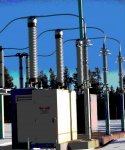.
I wouldn't give up on the subject yet, KPO- but I would sit back after your scientific inquiry and weigh all your odds.
I have dealt with lightning, static, St. Elmo's fire-- you name it-- all my professional life. And in having it presented in so many 'in my face' scenarios, I have become very philosophical about the subject.
Quite a few people in here have given you some good advice- now you have to sift it and decide where you want to take it.
_____________________________________________________________
Extrapolating this to real life:
As a government scientist I work to the standards of perfection (well, usually)- and static suppression

St. Elmo's Fire
is something always high on my lists. Yet anyone following my posts will quickly conclude I take sort of a perverse pleasure in recounting my professional and private lightning/static experiences-- and disasters-- all the perfections be damn'd.
My evolving philosophy about everything Zesus throw that goes "Zap !" is that if he has your number that day, you are screw'd. I have seen how he has laughed at the most harden'd EMP facilities- to ever believe you can be absolute 100% protected... and tho I will no doubt catch flak for saying this, don't let anyone convince you otherwise.
With that being said, always keep in mind that the average household has a virtually zero chance of ever suffering a direct hit- all the popular legends, myths and news stories to the contrary.... but that is, if you don't do sometime to try and attract it...... a 120 foot tower comes to mind.
The real danger you face is from the secondary voltage spikes that will come in to your house over a myriad of paths- from power, telephone, data, cable TV lines- your water and gas pipes- to name a few more exotics. But those paths and spikes you can definitely do something about.
I adhere to what is called a "floating ground."
We use it exclusively at our remote sites. You can read about it in that IEEE booklet I cited earlier. With such a system I feel reasonably certain our equipment will withstand everything except a direct hit.
Okay, I was talking suppression at the big $$ levels. What is a homeowner to do ?
This is strictly Coyote talking now---

After you have done a 'floating ground" about your house al la the IEEE guidelines-- Sit back and stop worrying.
Zesus will see and appreciate your efforts and take is wrath out on someone else.
People have thought me kind'a afflicted, but I have been known to take a bottle of wine outside into the heart of a thunderstorm and offer him a glass (I'm told Zesus likes a pinot noir, but don't hold me to that

) - It never hurts, and I like to think after all these years he and I have come to a peaceful coexistence.

Seriously, do all you can
Reasonably do, and then let it go.
An example:
I and some friends own an old mining claim high up in the Rockies. It consists of a cabin above treeline, some out buildings-- all at over 12,000 feet. We can experience St. Elmo's fire practically every time a charged cloud rolls across the surrounding 14' teen'rs and settles into the our alpine cirque. Naturally everything that is metallic is ground'd- stove flue pipe, propane lights-- and it does
Reduce the errie displays...
We have radios up there and one is a CB. I have taken a different bend on its static suppression....There is really none.
A large RF choke runs from its base to the "floating ground"- and there is a big aluminium ball that graces its peak... but that's all.
With that modest arrangement we don't get the 'fire' about this antenna, and if by chance it does take a direct hit ?... hey, its a CB radio.
Do what is do-able and then go on and enjoy your hobby, KPO
Lauri

.
.




